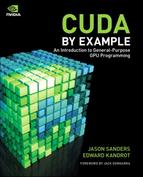Preface
This book shows how, by harnessing the power of your computer’s graphics process unit (GPU), you can write high-performance software for a wide range of applications. Although originally designed to render computer graphics on a monitor (and still used for this purpose), GPUs are increasingly being called upon for equally demanding programs in science, engineering, and finance, among other domains. We refer collectively to GPU programs that address problems in nongraphics domains as general-purpose. Happily, although you need to have some experience working in C or C++ to benefit from this book, you need not have any knowledge of computer graphics. None whatsoever! GPU programming simply offers you an opportunity to build—and to build mightily—on your existing programming skills.
To program NVIDIA GPUs to perform general-purpose computing tasks, you will want to know what CUDA is. NVIDIA GPUs are built on what’s known as the CUDA Architecture. You can think of the CUDA Architecture as the scheme by which NVIDIA has built GPUs that can perform both traditional graphics-rendering tasks and general-purpose tasks. To program CUDA GPUs, we will be using a language known as CUDA C. As you will see very early in this book, CUDA C is essentially C with a handful of extensions to allow programming of massively parallel machines like NVIDIA GPUs.
We’ve geared CUDA by Example toward experienced C or C++ programmers who have enough familiarity with C such that they are comfortable reading and writing code in C. This book builds on your experience with C and intends to serve as an example-driven, “quick-start” guide to using NVIDIA’s CUDA C programming language. By no means do you need to have done large-scale software architecture, to have written a C compiler or an operating system kernel, or to know all the ins and outs of the ANSI C standards. However, we do not spend time reviewing C syntax or common C library routines such as malloc() or memcpy(), so we will assume that you are already reasonably familiar with these topics.
You will encounter some techniques that can be considered general parallel programming paradigms, although this book does not aim to teach general parallel programming techniques. Also, while we will look at nearly every part of the CUDA API, this book does not serve as an extensive API reference nor will it go into gory detail about every tool that you can use to help develop your CUDA C software. Consequently, we highly recommend that this book be used in conjunction with NVIDIA’s freely available documentation, in particular the NVIDIA CUDA Programming Guide and the NVIDIA CUDA Best Practices Guide. But don’t stress out about collecting all these documents because we’ll walk you through everything you need to do.
All of the required NVIDIA software can be found linked from http://developer.nvidia.com/object/gpucomputing.html. Chapter 2 of this book discusses which components are absolutely necessary in order to get started writing CUDA C programs. Because this book aims to teach by example, it contains a great deal of code samples. This code can be downloaded from http://developer.nvidia.com/object/cuda-by-example.html.
Without further ado, the world of programming NVIDIA GPUs with CUDA C awaits!
